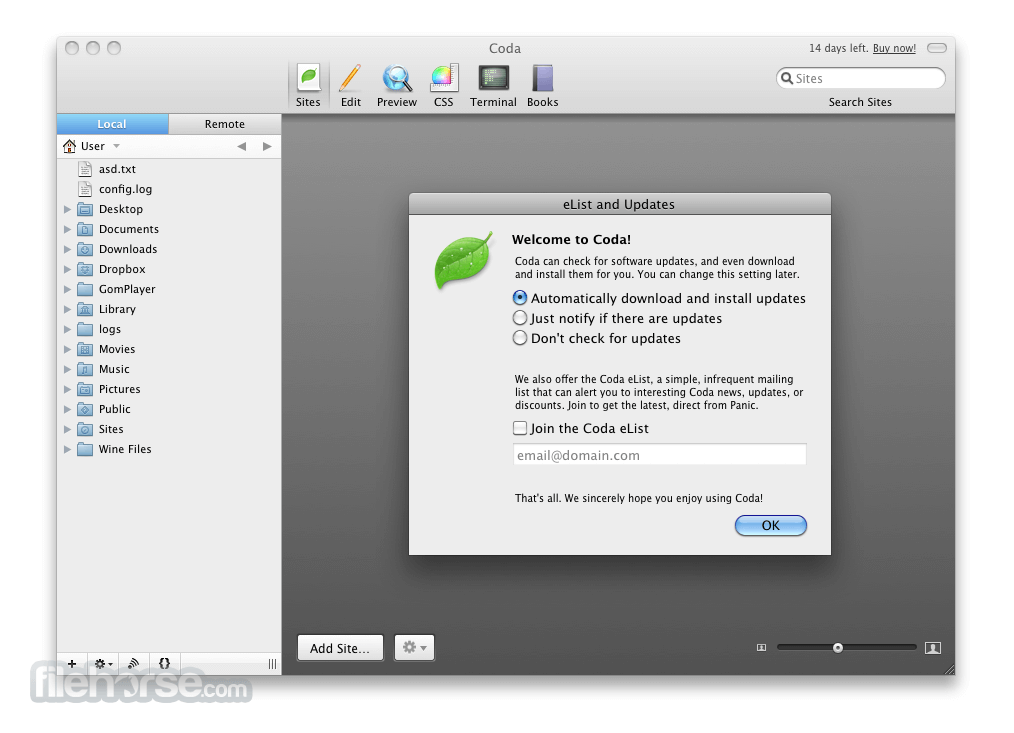| Developer(s) | Panic |
|---|---|
| Initial release | April 23, 2007 |
| Stable release | |
| Platform | macOS |
| Type | Web development |
| License | Proprietary, shareware with a 7-day trial |
| Website | www.panic.com/coda/ |
Coda is a commercial and proprietary web developmentapplication for macOS, developed by Panic. It was first released on April 23, 2007 and won the 2007 Apple Design Award for Best User Experience. Coda version 2.0 was released on 24 May 2012, along with an iPad version called Diet Coda. Although formerly available on the Mac App Store, it was announced on May 14, 2014 that the update to Coda 2.5 would not be available in the Mac App Store due to sandboxing restrictions.[2]
Every Coda offers a full complement of eyelets and rack mounts to simplify installation of a rear carrier, fenders and ring lock. Geared to Go Anywhere. The drivetrains on all our Codas feature long cage ATB rear derailleurs, full-size triple chainring cranksets (48/36/26 or 48/38/28) and big 11-32 cassette blocks. July 31, 2008 Addition of intent statement to Standard 1-5 Adopted and Implemented January 29, 2009 Revised Standards 2-2 and 3-2 Adopted and Implemented July 31, 2009 Revised Definition of Terms (Anxiety and Pain Control), Revised Standards 2-6 and 5-3 Adopted and Implemented August 6, 2010 Revised Accreditation Status Definitions section. You code for the web. You demand a fast, clean, and powerful text editor.Pixel-perfect preview.A built-in way to open and manage your local and remote files.And maybe a dash of SSH.Say hello, Coda. 'For the Damaged Coda' is taken from the fifth studio album by Blonde Redhead, 'Melody of Certain Damaged Lemons', released on June 6, 2000. Website: http://.
Concept and idea[edit]
The concept for Coda came from the web team at Panic, who would have five or six different programs for coding, testing and reference. The lack of full-featured website development platforms equivalent to application development platform Xcode served as the purpose for Coda's creation. Poster mill 1 4.
Development[edit]
Currently, little is known about the actual development of Coda. What is known from Panic co-founder Steven Frank's blog is that Coda development started at Panic sometime in late 2005.[3] Assigned to the project were 5 engineers, 3 people on support and testing, one designer, and one Japanese localizer.[3]
Sections[edit]
The application is divided into six sections (Sites, Edit, Preview, CSS, Terminal, and Books), which are accessed through six tabs at the top of the application. Users can also split the window into multiple sections either vertically or horizontally, to access multiple sections or different files at the same time.
Sites[edit]
In Coda, sites are the equivalent of 'projects' in many other applications like TextMate. Each site has its own set of files, its own FTP settings, etc. When Coda is closed in the midst of a project and then reopened, the user is presented with exactly what it was like before the application was closed. Another notable feature is the ability to add a Local and Remote version to each site, allowing the user to synchronize the file(s) created, modified or deleted from their local and remote locations.
Files[edit]
Coda incorporates a slimmed down version of the company's popular FTP client, Transmit, dubbed 'Transmit Turbo'. The Files portion is a regular FTP, SFTP, FTP+SSL, and WebDAV client, where the user can edit, delete, create, and rename files and folders.
Editor[edit]
The editor in Coda incorporates a licensed version of the SubEthaEdit engine, rather than having a custom one, to allow for sharing of documents over the Bonjour network. Coda also has a new Find/Replace mechanism, which allows users to do complex replaces using a method similar to regular expressions.
Coda also recognises specially-formatted comment tags in many syntaxes, called bookmarks, which appear in a separate pane beside the editor called the Code Navigator. Bookmarks allow the user to jump to the corresponding line of text from anywhere in the editor by clicking on the link in the Code Navigator.[4]
Plug-ins[edit]
Coda 1.6 and later supports plug-ins, which are scripts usually written in command line programming languages like Cocoa, AppleScript, Perl, or even shell scripting languages like bash, that appear in Coda's menu bar and do specific tasks like appending URLs or inserting text at a certain point. Plug-ins can either be written using Xcode or through Panic's free program, the Coda Plug-in Creator.
Command-line utility[edit]
Byword 2 6 1 – minimalist typing interface. Fabfilter total bundle 2019. Coda does not come with its own command-line utility. Instead, a third-party utility such as coda-cli can be used.
Reviews[edit]
Coda 1[edit]
Coda 1 received a review of 3.5/5 mice from Macworld.[5] It received 4/5 stars from CNET's Download.com.[6]

Coda 2[edit]
Coda 2 received a rating of 4.5/5 mice from Macworld.[7]
Coda 2 7 5 Full Movie
References[edit]
Coda 2 7 5 Full Version
- ^'Coda 2 Release Notes'. Panic.com. Retrieved 11 February 2020.
- ^'Panic Blog » Coda 2.5 and the Mac App Store'. Panic.com. Retrieved 22 October 2017.
- ^ ab'~stevenf: Announcing Coda 1.0'. 5 May 2007. Archived from the original on 5 May 2007. Retrieved 22 October 2017.
- ^'Panic - Coda - Developer'. 20 February 2012. Archived from the original on 20 February 2012. Retrieved 22 October 2017.
- ^'Download Coda 1.0.3 - Macworld'. Macworld. Archived from the original on 2014-09-14. Retrieved 2016-04-03.
- ^'Coda'. Download.com. Retrieved 2016-04-03.
- ^'Coda 2 dramatically improves an already very good code editor'. Macworld.com. Retrieved 2016-04-03.
